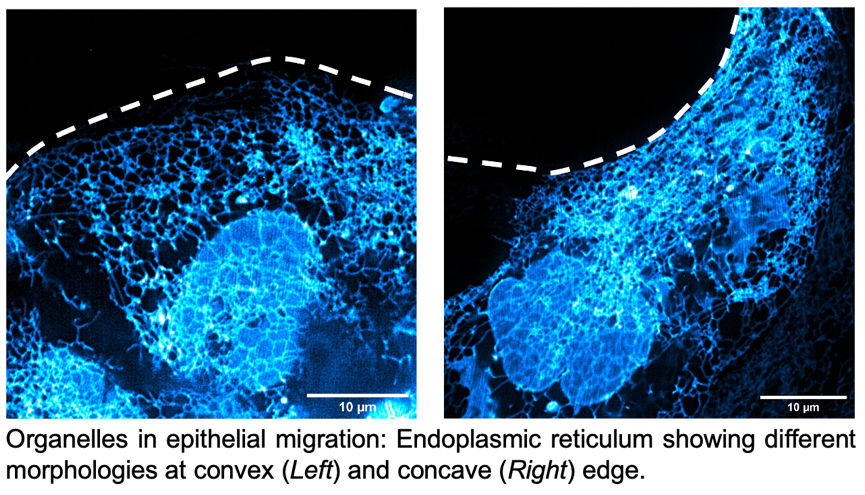Research
Decoding Teamwork in Tissues: Our lab delves into how epithelial cells work together (collective cell dynamics) to shape organs (morphogenesis), maintain balance (homeostasis), and heal (regeneration). We use cutting-edge tools to explore these processes in development, wound healing, and cancer across diverse models (cell lines, organoids, mice). Our research aims to unlock breakthroughs in regenerative medicine, cancer biology, and tissue function. Currently, there are three major directions:
I. Sculpting Life: Epithelial Morphogenesis in Development
We’re delving into how the shape and mechanics of biological systems affect epithelial tissue development, alongside genetic and chemical factors. Using mouse embryos and a special 3D organoid model, we’ll study how the polarized epithelial tissues and the structures arising from them (e.g. inner ear, skin, etc.) form from basic cell layers. By examining the interplay between physical forces and biochemical signals, we hope to understand the process better. Our goal is to create a detailed picture of epithelial tissue development, showing what factors control it and keep it balanced. This research not only deepens our grasp of how bodies grow but also holds promise for making more consistent and precise organoids for medical purposes, like studying diseases or testing drugs.
Funding: TIFR intramural funding (DAE), Human Frontier Science Program (HFSP)
Collaborator(s): Prof. Max Bi, Northeastern University, Boston, USA; Prof. Friedhelm Serwane, LMU Munich, Germany.

II. Unveiling the homeostasis against cancer-causing mutations: Beyond the Barrier
Our research delves deeper than the epithelial barrier, exploring how these vigilant cells collectively identify and eliminate potential threats before they turn cancerous. We’ve made significant strides in understanding this intricate defense system, as highlighted in our publications. Our focus lies on the interplay between tissue mechanics and geometry in this defense. How do physical forces within the tissue and the arrangement of cells themselves influence their ability to detect and eliminate mutated cells? By unraveling these secrets, we hope to identify novel strategies that go beyond traditional barriers, potentially leading to new avenues for cancer prevention and treatment.
Funding: TIFR intramural funding (DAE), DBT/Wellcome Trust India Alliance
Collaborator(s): Prof. Max Bi, Northeastern University, Boston, USA; Prof. Yasuyuki Fujita, Kyoto University, Japan.

III. The Healing Waltz: Orchestrating Epithelial Repair
Epithelial wound healing is a mesmerizing ballet of collective cell movement and internal restructuring. We delve into the intricate choreography behind this process. Our research focuses on how cellular organelles rearrange themselves during this dance, particularly how leader cells form and how these rearrangements influence overall wound closure. We utilize both epithelial monolayers and mouse embryonic skin models to understand how organelles within individual cells orchestrate the collective healing symphony, ultimately aiming to accelerate healing and promote efficient tissue regeneration.
Funding: TIFR intramural funding (DAE), Partner group award by the Max Planck Society (MPG), SERB Core Research Grant.
Collaborator(s): Prof. Fabian Spill, University of Birmingham, UK.

Long-term Vision: Our lab is committed to unraveling the intricate dynamics of epithelial tissues in development, defense against cancer, and wound healing. Through cutting-edge research spanning from mouse embryos to organoid models, we aim to decode the teamwork of cells in shaping organs, maintaining balance, and orchestrating repair. By understanding the interplay between biophysical and biochemical factors, our long-term goal is to unlock breakthroughs in regenerative medicine, cancer biology, and tissue function.
Grants
- HFSP Research Grant (2022-2025) in collaboration with Friedhelm Serwane (LMU Munich, Germany) and Dapeng (Max) Bi (Northeastern University, USA) on “Dynamics of multilayer epithelial structures: Integrative mechanical characterization of epidermis”
- Core Research Grant (2021-2024) by SERB, India on “Mechanobiology of micron-scale curvature sensing during epithelial gap closure”
- DBT/Wellcome Trust India Alliance Intermediate Fellowship (2018-2022) on “Mechanobiology of cell competition”
- Partner Group Award (2017-2023) by the Max Planck Society, Germany on “Collective cell migration”
